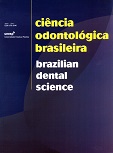Efeito do tempo de condicionamento da superfície cerâmica sobre a resistência adesiva entre uma cerâmica de fluorapatita e um cimento resinoso
DOI:
https://doi.org/10.14295/bds.2005.v8i3.432Abstract
O objetivo deste estudo foi avaliar a resistência de união entre uma cerâmica sintética de fluorapatita e leucita livre de feldspato e um cimento resinoso dual, variando o tempo de condicionamento ácido da superfície da cerâmica. Foram confeccionados 16 blocos de cerâmica (IPS d. SIGN- Ivoclar-Vivadent) que foram divididos aleatoriamente em 2 grupos (n=8), conforme o tempo de condicionamento ácido da superfície cerâmica: G1 - condicionamento durante 30 segundos com ácido fluorídrico 10%, seguido da aplicação do agente silano (Primer ceramic, 3M/Espe); G2: condicionamento com ácido fluorídrico 10% durante 2 minutos, seguido da aplicação do silano (Primer ceramic, 3M/Espe). Os blocos de cerâmica foram unidos a blocos de resina composta, recém confeccionados, (Fill Magic, Vigodent) com o cimento resinoso Rely X (3M/Espe) sob uma carga de 750g. Os conjuntos foram armazenados em água por 24h e seccionados em dois eixos, x e y, obtendo-se corpos-de-prova (CP) com área de aproximadamente 0,7 mm2. Os CP foram submetidos ao ensaio de microtração a uma velocidade de 0,5 mm/min. Os resultados foram submetidos a duas análises estatísticas utilizando todos os CP, incluindo os com valores zero (G1 = 12,99 ± 6,7 MPa e G2 = 14,97 ± 3,7 MPa) e excluindo os com valores zero (G1 = 20,19 ± 3,8 MPa e G2 = 22,31 ± 2,8 MPa). Não foi observada diferença estatística entre os grupos em nenhuma das análises (p>0,05).Downloads
Downloads
Published
How to Cite
Issue
Section
License
Brazilian Dental Science uses the Creative Commons (CC-BY 4.0) license, thus preserving the integrity of articles in an open access environment. The journal allows the author to retain publishing rights without restrictions.
=================




























